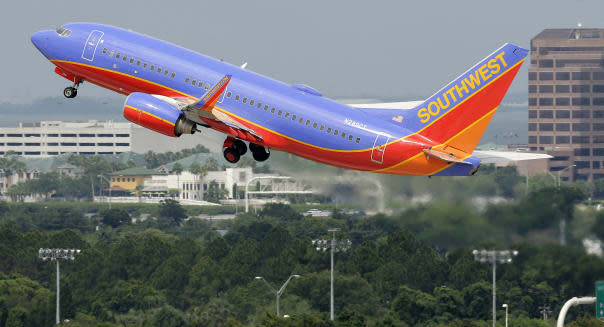Will Travelers Profit From Airlines' Soaring Returns?

It's a good time to be an airline. Last year, the price of crude oil swooned, from over $115 a barrel to barely over $55; these days it's just below $50. This is a particularly good situation for air carriers, as far and away their No. 1 cost -- aside from salaries -- is fuel.
As a result, earlier this year the International Air Transport Association raised its estimate for collective 2015 profit for the airline business. It hiked its forecast a mighty 17 percent to $29.3 billion.
When a business or industry starts raking in more dough, they have more scope to be generous. Theoretically, with their windfall the airlines could cut us weary travelers a break in the form of lower ticket prices, a reprieve from pesky little fees for things like baggage, etc. Is it likely we'll see that happen anytime soon?
Profits Are a Gas
American Airlines (AAL) is Exhibit A for current airline prosperity. The carrier posted an excellent second quarter, booking a $1.9 billion net profit for the highest quarterly bottom line in its history.
Even more impressive was Southwest (LUV). The always-scrappy airline announced last month that it had also booked a record quarter in its second quarter, netting $608 million. That was, by the way, the latest in a series of all-time-high quarterly net profit results for the company.
Such is the power of lower input costs. Collectively, in the first quarter of this year alone, American, Delta (DAL), Southwest and United Airlines (UAL) saved around $3.3 billion on fuel. That leaves a lot of room for profit to expand ... and for airlines to bring back some of those perks and freebies we passengers used to enjoy.
Soaring Planes, Soaring Fares
Except that they almost certainly won't.
There are numerous reasons for this. The first is plain and simple. Airlines have been raising fares habitually -- and with great consistency -- for years.
%VIRTUAL-WSSCourseInline-908%Figures from the Department of Transportation, which tracks the average U.S. airline ticket price, tell the story. From 1995 to 2014, adjusted for inflation, the average price rose by a cumulative 34 percent to $392. In all but six of those years, the average fare was higher than its predecessor, in some cases dramatically so.
The second reason is consolidation. In the early 2000s, 10 airlines did most of the passenger transport business in America. The business has consolidated greatly since then -- US Airways is now a part of American Airlines, while Continental has been folded into United and AirTran absorbed by Southwest.
These days, a group of four incumbents -- American, United, Delta and Southwest -- rule the market. Data compiled by the Bureau of Transportation Statistics revealed that from June 2014 to May 2015, the quartet controlled around 62 percent of the domestic market. And of course, as with any industry, the tighter the consolidation, the less choice a consumer has for the offered product.
Lastly, there is quite simply more demand for seats on an airplane these days. The total number of passengers, following a dip in 2009 (the height of the Great Recession), has grown steadily. Across that stretch of time, the highest annual increase was recorded last year.
Airlines are introducing larger, higher-capacity planes to their fleets to accommodate this. But even with the extra space, the industry's load factor -- i.e., how full the planes are -- is also on the rise.
With the exception of 2008, the load factor for domestic carriers has increased on an annual basis every single year over the past decade, with 2014 taking the crown at over 84 percent. These days, it seems that nearly every plane flies at or near capacity, which wasn't the case in the recent past. The industry's overall load factor in 2002, for example, was "only" 70 percent.
Intended Destinations
For their part, the airlines and their allies say carriers are using those bigger profits to benefit the consumers. Industry association Airlines For America opines that the sector's newfound profitability is "modest," pointing out that net margins are "far below" that of the average company in the S&P 500 index.
Additionally, writes the organization, carriers "are investing back into the business at a rate of $1 billion a month in improving airports, making the onboard experience better with larger overhead bins and increasing Wi-Fi access, and acquiring the equivalent of one new plane every day this year."
Meanwhile, it's anyone's guess what's going to happen with that big-cost item -- the association emphasizes that dips in fuel prices are often short-lived. Although the current crude oil price trough seems to be a durable trend, many factors could cause that price to rise again, suddenly and without warning.
A Piece of the Action
Regardless, at the moment the only real way for us ordinary folk to directly profit from this perfect storm for airline profits is to own stock in a carrier. Over the past year, airline share prices have risen by 7 percent (American) to a jealousy-inducing 31 percent (Southwest).
That's no surprise, given that they operate an increasingly in-demand service and there are very few of them. It's just too bad that their good times won't translate into lower ticket prices for the rising numbers of people traveling on their planes.
Eric Volkman has no position in any stocks mentioned, but somehow, in spite of all the negatives, he still likes to fly. The Motley Fool has no position in any of the stocks mentioned. Try any of our Foolish newsletter services free for 30 days. Check out The Motley Fool's one great stock to buy for 2015 and beyond.

